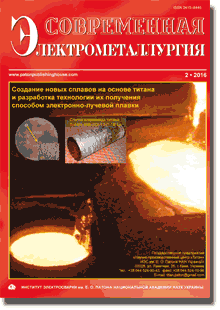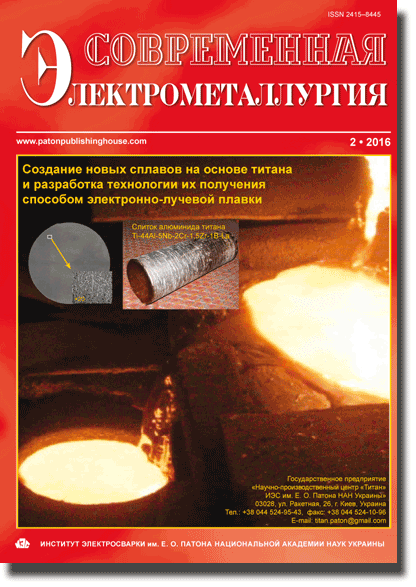| 2016 №02 (03) |
DOI of Article 10.15407/sem2016.02.04 |
2016 №02 (05) |

Современная электрометаллургия, 2016, #2, 28-38 pages
Эффективность электронно-лучевого осаждения защитных покрытий на основе SiC на циркониевые оболочки ТВЭЛов
А. И. Устинов1, Н. Ф. Гадзыря2, Я. Г. Тимошенко2, А. А. Мохнюк1, Т. В. Мельниченко1, В. A. Теличко1, С. О. Демченков1
1Институт электросварки им. Е. О. Патона НАН Украины. 03680, г. Киев-150, ул. Казимира Малевича, 11. E-mail: office@paton.kiev.ua
2Институт проблем материаловедения им. И. Н. Францевича НАН Украины. 03680, г. Киев, ул. Кржижановского, 3. E-mail: taltos@ukr.net
Abstract
Благодаря своим физико-химическим свойствам карбид кремния (SiC) рассматривается как наиболее перспективный материал в ядерном материаловедении при изготовлении оболочек ТВЭЛов, защитных покрытий и других элементов конструкции ядерных реакторов. Основным фактором, сдерживающим практическое применение SiC, является отсутствие эффективных технологий изготовления деталей и осаждения покрытий на основе этого соединения. Учитывая, что в ближайшей перспективе станет актуальным повышение долговечности эксплуатации ТВЭЛов в стационарных и аварийных режимах, в работе рассмотрены возможности получения покрытий на основе SiC на циркониевых оболочках ТВЭЛов методом электронно-лучевого осаждения. Покрытия на основе SiC, с одной стороны, не должны оказывать существенного влияния на тепловые режимы работы ТВЭЛов, а с другой, обеспечивать защиту циркониевых оболочек от пароциркониевой реакции при их нагреве в парах воды. Применение электронно-лучевого осаждения покрытий основе SiC расширится, если этот метод обеспечит высокую скорость осаждения покрытий с высоким уровнем адгезии, а структура покрытия позволит защитить циркониевую оболочку от коррозии в перегретой воде и при контакте с ее парами при высоких температурах. В работе была достигнута скорость осаждения до 5 мкм/мин путем оптимизации структуры керамических мишеней на основе SiC и условий их электронно-лучевого испарения в вакууме. Показано, что совмещение процесса электронно-лучевого испарения с обработкой подложки ионами аргона обеспечивает высокий уровень адгезии при температурах осаждения ниже 600 °С, а также снижение степени дефектности покрытия. Нагрев циркониевых оболочек с покрытиями на основе SiC до 1200 °С в атмосфере пара подтвердил возможность повышения их стойкости к окислению. Библиогр. 36, табл. 1, рис. 13.
Ключевые слова: покрытия; карбид кремния; электронно-лучевое осаждение; коррозионная стойкость; пароциркониевая реакция
Received: 10.02.16
Published: 23.06.16
References
1. Preventing hydrogen explosions in severe nuclear accidents: Unresolved safety issues involving hydrogen generation and mitigation: NRDC Report 2014.
2. Advanced LWR fuels research in the United States. Shannon Bragg-Sitton: Idaho National Laboratory, 2013.
3. Westinghouse Accident Tolerant Fuel Program. Westinghouse Electric Company LLC, 2013.
4. Singh, K., Limaye, P.K., Soni, N.L. et al. (2005) Wear studies of (Ti–Al)N coatings deposited by reactive magnetron sputtering. Wear, 258, 1813–1824. https://doi.org/10.1016/j.wear.2004.12.023
5. Korablov, S., Ibrahim, M.A., Yoshimura, M. (2005) Hydrothermal corrosion of TiAlN and CrN PVD films on stainless steel. Corrosion Science, 47, 1839–1854. https://doi.org/10.1016/j.corsci.2004.08.009
6. Budi, Esmar, Hadi, Nasbey, Agus, Setyo, Budi (2013) Electrodeposition of Ni–TiAlN nanocomposite coating for wear and corrosion protection: A Review. In: Seminar Nasional Fisika Proc. Jakarta: Universitas Negeri.
7. Fauzia, Khatkhatay, Liang, Jiao, Jie, Jian et al. (2014) Superior corrosion resistance properties of TiN-based coatings on Zircaloy tubes in supercritical water. Journal of Nuclear Materials, 451, 346–351. https://doi.org/10.1016/j.jnucmat.2014.04.010
8. Liu, Y., Bhamji, I., Withers, P.J. et al. (2015) Evaluation of the interfacial shear strength and residual stress of TiAlN coating on ZIRLO™ fuel cladding using a modified shear-lag model approach. Ibid., 466, 718–727. https://doi.org/10.1016/j.jnucmat.2015.06.003
9. Kuprin, А.S., Belous, V.А., Voyevodin, V.N. et al. (2015) Vacuum-arc chromium-based coatings for protection of zirconium alloys from the high-temperature oxidation in air. Ibid., 456, 400–406.
10. Kuprin, А.S., Belous, V.А. (2015) Vacuum-arc chromium coatings for protection of alloy Zr–1Nb from high-temperature oxidation in air. VANT, 96, 2, 111–118.
11. Kuprin, A.S., Belous, V.A., Bryk, V.V. et al. (2014) High-temperature oxidation in air of zirconium alloy E-110 and Zr–1Nb shells with coatings. Ibid., 89, 1, 126–132.
12. Kopanetz, I.E., Tolstolutskaya, G.D., Nikitin, A.V. et al. (2015) The effect of Cr, Cr–N and Cr–Ox coatings on deuterium retention and penetration in zirconium alloy Zr–1Nb. Ibid., 99, 5, 81.
13. Belous, V.A., Leonov, S.A., Nosov, G.I. et al. (2009) Modifying of alloy E-110 surface by deposition of multilayer Zr/ZrN coatings using ion radiation. PhIP, 7, 1–2, 76–81.
14. Jeong-Yong, Park, Il-Hyun, Kim, Yang-Il, Jung et al. (2013) High temperature steam oxidation of Al3Tibased alloys for the oxidation-resistant surface layer on Zr fuel claddings. Journal of Nuclear Materials, 437, 75–80. https://doi.org/10.1016/j.jnucmat.2013.01.338
15. Ting, Cheng, Keiser, J.R., Brady, M.P. et al. (2012) Oxidation of fuel cladding candidate materials in steam environments at high temperature and pressure. Ibid., 427, 396–400.
16. Riviere, J.-P., Delafond, J., Misaelides, P. (1998) Corrosion protection of an AISI 321 stainless steel by SiC coatings. Surface and Coatings Technology, 100–101, 243–246. https://doi.org/10.1016/S0257-8972(97)00622-1
17. Katoh, Y., Snead, L.L., Henager, C.H. Jr. et al. (2007) Current status and critical issues for development of SiC composites for fusion applications. Journal of Nuclear Materials, 367–370, 659–671. https://doi.org/10.1016/j.jnucmat.2007.03.032
18. Katoh, Y., Snead, L.L., Henager, C.H.Jr. et al. (2014) Radiation-tolerant joining technologies for silicon carbide ceramics and composites. Ibid., 448, 497–511.
19. Liao, F., Park, S., Larson, J.M. et al. (2003) High-rate chemical vapor deposition of nanocrystalline silicon carbide films by radio frequency thermal plasma. Materials Letters, 57, 13–14, 1982–1986. https://doi.org/10.1016/S0167-577X(02)01116-3
20. Shikama, T., Kitajima, M., Fukutomi, M. et al. (1984) Erosion behaviour of physically vapour-deposited and chemically vapour-deposited SiC films coated on molybdenum during oxygenated argon beam thinning. Thin Solid Films, 117, 3, 191–199. https://doi.org/10.1016/0040-6090(84)90286-4
21. Huidong, Tang, Shouhong, Tan, Zhengren, Huang et al. (2005) Surface morphology of ?-SIC coatings deposited by RF magnetron sputtering. Surface and Coatings Technology, 197, 2–3, 161–167.
22. Wang, M., Huang, A.P., Wang, B. et al. (2001) Bias effects on structure of sputtered SiC films. Materials Science and Engineering В, 85, 1, 25–27. https://doi.org/10.1016/S0921-5107(01)00621-3
23. Jin, C.G., Wu, X.M., Zhuge, L.J. (2008) Room-temperature growth of SiC thin films by dual-ion-beam sputtering deposition. Research Letters in Physical Chemistry, 1–5. https://doi.org/10.1155/2008/760650
24. Wang, X.H., Eguchi, K., Iwamoto, C. et al. (2003) Ultra-fast thermal plasma physical vapor deposition of thick SiC films. Science and Technology of Advanced Materials, 4, 2, 159–165. https://doi.org/10.1016/S1468-6996(03)00016-0
25. Jin, C.G., Yu, T., Zhao, Y. et al. (2011) Room temperature deposition of amorphous SiC thin films using low energy ion bombardment. Physica E, 43, 10, 1863–1866. https://doi.org/10.1016/j.physe.2011.06.029
26. ElGazzar, H., Abdel-Rahman, E., Salem, H.G. et al. (2010) Preparation and characterizations of amorphous nanostructured SiC thin films by low energy pulsed laser deposition. Applied Surface Science, 256, 7, 2056–2060. https://doi.org/10.1016/j.apsusc.2009.09.047
27. Paton, B.E., Movchan, B.A. (1991) Composite materials deposited from the vapour phase in vacuum. Welding and Surfacing Review, 2, 43–64.
28. Movchan, B.A. (2006) Inorganic materials and coatings produced by EBPVD. Surface Engineering, 22(1), 35–46. https://doi.org/10.1179/174329406X85029
29. Yi, J., He, X.D., Sun, Y. (2008) Characterization of a stoichiometric SiC film deposited on a thermally oxidized Si substrate. Journal of Alloys and Compounds, 451, 11–13. https://doi.org/10.1016/j.jallcom.2007.07.042
30. Costa, A.K., Camargo, S.S.Jr., Achete, C.A. et al. (2000) Characterization of ultra-hard silicon carbide coatings deposited by RF magnetron sputtering. Thin Solid Films, 377–378, 243–248. https://doi.org/10.1016/S0040-6090(00)01321-3
31. Knotek, O., Lfffler, F., Wolkers, L. (1993) Amorphous SiC PVD coatings. Diamond and Related Materials, 2(2–4), 528–530. https://doi.org/10.1016/0925-9635(93)90114-H
32. Simao, R.A., Costa, A.K., Achete, C.A. et al. (2000) Magnetron sputtering SiC films investigated by AFM. Thin Solid Films, 377–378, 490–494. https://doi.org/10.1016/S0040-6090(00)01371-7
33. Lee, Jin-Seok, Young-Soo, Ahn, Nishimura, T. et al. (2012) Effect of Al4SiC4 additive on the densification of ?-silicon carbide under vacuum. Journal of the European Ceramic Society, 32(3), 619–625. https://doi.org/10.1016/j.jeurceramsoc.2011.10.003
34. Li, Wen-Jun, Tu, Rong, Goto, T. (2005) Preparation of TiB2–SiC eutectic composite by an arc-melted method and its characterization. Materials Transactions, 46(11), 2504–2508. https://doi.org/10.2320/matertrans.46.2504
35. Cho Kyeong Sik, Kwang Soon Lee (2005) Microstructure and mechanical properties of spark-plasma-sintered SiC–TiC composites. Key Engineering Materials, 287, 335–339. https://doi.org/10.4028/www.scientific.net/KEM.287.335
36. Cho Kyeong Sik, Kwang Soon Lee (2005) Effects of Al, B and C additives on microstructure and mechanical properties of spark-plasmasintered SiC ceramics. Ibid., 287, 329–334.
The cost of subscription/purchase order journals or individual articles
| Journal/Currency | Annual Set | 1 issue printed |
1 issue |
one article |
| TPWJ/USD | 384 $ | 32 $ | 26 $ | 13 $ |
| TPWJ/EUR | 348 € | 29 € | 24 € | 12 € |
| TPWJ/UAH | 7200 UAH | 600 UAH | 600 UAH | 280 UAH |
| AS/UAH | 1800 UAH | 300 UAH | 300 UAH | 150 UAH |
| AS/USD | 192 $ | 32 $ | 26 $ | 13 $ |
| AS/EUR | 180 € | 30 € | 25 € | 12 € |
| SEM/UAH | 1200 UAH | 300 UAH | 300 UAH | 150 UAH |
| SEM/USD | 128 $ | 32 $ | 26 $ | 13 $ |
| SEM/EUR | 120 € | 30 € | 25 € | 12 € |
| TDNK/UAH | 1200 UAH | 300 UAH | 300 UAH | 150 UAH |
| TDNK/USD | 128 $ | 32 $ | 26 $ | 13 $ |
| TDNK/EUR | 120 € | 30 € | 25 € | 15 € |
AS = «Automatic Welding» - 6 issues per year;
TPWJ = «PATON WELDING JOURNAL» - 12 issues per year;
SEM = «Electrometallurgy Today» - 4 issues per year;
TDNK = «Technical Diagnostics and Non-Destructive Testing» - 4 issues per year.





